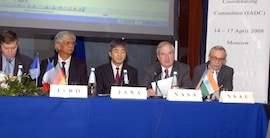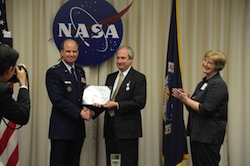Updated: Nick Johnson, Chief Scientist of Orbital Debris, Says Goodbye to NASA
Updated: 5/16/14 A series of Knowledge Bytes featuring Nick Johnson is now available. In these videos, Johnson discusses handling requirement changes, Operation Burnt Frost, and the history and future of Orbital Debris work.
From the White House Situation Room to the halls of the United Nations (U.N.) to the International Space Station (ISS), Nick Johnson has left his mark.
Johnson retired March 28, 2014, saying goodbye to NASA after 18 years as NASA's chief scientist of Orbital Debris (OD) and 10 as the OD Program Office's (ODPO) program manager.
As the agency and U.S. subject matter expert in OD, Johnson has helped the OD community overcome challenges and led major changes worldwide.
Looking Back: Career Highlights
According to Program Manager Gene Stansbery of the ODPO, Johnson played a key role in developing and implementing OD guidelines and standards for NASA, other U.S. government agencies, the Inter-Agency Space Debris Coordination Committee (IADC) and the U.N.
"The similarity in all of these [standards] has established a level playing field for U.S. and foreign space operators while at the same time protecting the environment," said Stansbery.
In 1997, Johnson helped develop the U.S. Government Orbital Debris Mitigation Standard Practices. These measures spell out how to design, operate and dispose of spacecraft and launch vehicles without creating more OD.
In support of a U.S. government interagency strategy, Johnson served as the lead U.S. negotiator, first at the IADC and then at the U.N., in the creation of international OD mitigation guidelines. The resulting U.N. guidelines were adopted in 2007, six years after the U.S. ones.
"Of all the things I've done, those are going to have the most long-lasting and positive effects," said Johnson.
Over the years, Johnson has seen the IADC grow from four countries to 12 with more than 60 countries represented at the annual meeting of the U.N. Committee on the Peaceful Uses of Outer Space.
"We now have the attention of all the major space players," said Johnson. "They all understand, so they promote, not only within their own countries, better stewardship of the environment."

Johnson (second from right) serving as head of NASA delegation to IADC in Moscow in 2008.
While leading these international changes, Johnson also played a crucial role in the space program back home. Micro-meteoroid and OD pose serious threats to the ISS, and Johnson is widely recognized as having played a major role in protecting it and the low-Earth orbit environment.
According to Michael Suffredini, manager of the ISS Program, Johnson was a key advisor to the ISS International Partner Program Managers at critical times. For example, he was instrumental in the response to Fengyun 1C, a Chinese satellite that was destroyed as part of an anti-satellite missile test, creating more OD than any other project, as well as two Briz-M events that occurred when the Russian launch vehicle broke up in orbit. His involvement in the aftermath of these incidents helped protect national and international interests in space.
"Nick protected [the] ISS and her crew well, and we will miss him,” said Suffredini.
Johnson's high-profile accomplishments have made headlines and garnered awards. In July 2008, he received the Department of Defense (DoD) Joint Meritorious Civilian Service Award and the NASA Distinguished Service Medal for his involvement with Operation Burnt Frost.
"One of the highlights of my career," acknowledged Johnson.
In late 2007, an inoperable U.S. satellite was falling back to Earth. The hazardous propellant on board posed a risk to people on the ground. With a couple months to go before the satellite would come crashing down, the DoD asked NASA to evaluate the true risk to humans around the world, an effort led by Johnson. Calculations showed the risk was much higher than with any previous re-entering vehicle.
At that time, the U.S. did not have a mechanism to counter the threat, so a broad government effort was initiated that included dozens of government agencies, contractors and military organizations.
"We threw the rule book out the window; we didn't go by protocol," said Johnson. "The administrator told me that I had whatever resources I needed at NASA to get the job done, and that's what I told the commander of U.S. Strategic Command who was in charge of the effort for the nation."

Johnson (middle), with his wife, Beth (right), receiving the DoD Joint
Meritorious Civilian Service Award.
Together, the team explored options to intercept the satellite and eventually concluded that blowing it up was the best option. Johnson briefed the president's science advisor, and the next day attended a meeting in the White House Situation Room to review the proposed plan of action. President George W. Bush later gave the final go-ahead to attempt the negation of the re-entry threat. Before it could be put into action, Johnson had to brief the U.N. on the U.S.'s plan with just 36 hours left on the clock.
"We were really concerned about the world's reaction, but the president was intent on mitigating or eliminating the risk and being transparent, so we told the entire world what we were going to do," explained Johnson.
Johnson advised the committee that the U.S. could not guarantee success. After all, they had modified hardware in just a few weeks' time and nothing like this had been done. At the end of his presentation, Johnson was pleasantly surprised that not a single person in the room made a negative comment.
When all was said and done, the U.S. was successful in eliminating the threat posed by the defunct satellite. The majority of the OD created came down within a few days, and the rest within a few months, leaving the space environment and the astronauts on the ISS free of additional threats.
"The process was remarkable, and you feel proud to be not only a member of NASA, but a citizen of the United States in what we did, and the fact that we were successful is just that much better," said Johnson.
There's no question: Johnson has had an impressive and fascinating career. As he prepares for his farewell, he looks back with admiration for NASA's Office of Safety and Mission Assurance (OSMA).
"I have great respect for the OSMA mission," said Johnson. "[There's] a lot of satisfaction in trying to engrain safety in people's lives at work and at home."
After he retires, he and his wife plan to move closer to family in Tennessee. While he may do some volunteer work, he doesn't intend to take on any new jobs.
His plan, he said, is simple, "Just be footloose and fancy-free, which I've never been accused of in my life!"